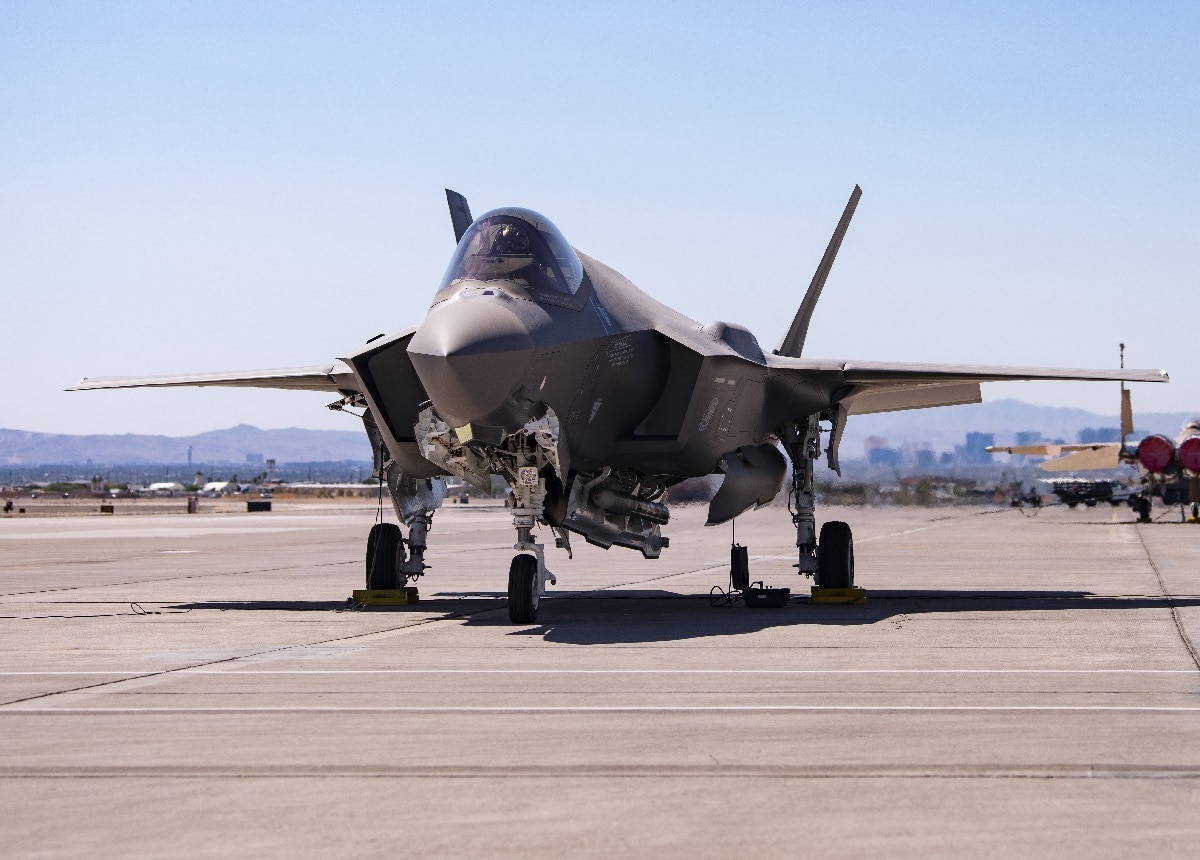The Lockheed Martin F-35 Lightning II is the most advanced and capable aircraft in service anywhere in the world today. Case in point: the United States Air Force continues to highlight how the fifth-generation fighter jet can be utilized in new and unique ways.
On Monday, the service announced that a pair of F-35A variants – the conventional takeoff and landing version of the Joint Strike Fighter – had recently completed the final flight test exercise of the nuclear design certification process. Two F-35As successfully released B61-12 Joint Test Assemblies (JTAs) during the first Full Weapon System Demonstration.
The aircraft are now one step closer to becoming the next Air Force aircraft, and the first fifth-generation platform, to successfully achieve compatibility with the nuclear gravity bomb. The two F-35As took off from Nellis Air Force Base (AFB), Nevada, and executed the Full Weapon System Demonstration – which is considered the “graduation” flight test exercise for achieving nuclear certification for an air-delivered platform.
This event was seen as the culmination of years of planning, as well as lead-up flight test activities. It involved not only the Air Force but organizations across the Department of Defense (DoD) and the Department of Energy (DoE).
Pilots from the 422d and 59th Test and Evaluation Squadrons led the Air Combat Command’s portion of the test effort, with Airmen from the 57th Aircraft Maintenance Squadron, 926th Aircraft Maintenance Squadron and Bolt Aircraft Maintenance Unit leading all maintenance efforts. Once airborne, test pilots flew to the Sandia National Laboratories’ Tonopah Test Range, located 160 miles from Nellis AFB, and released two high-fidelity, non-nuclear mock B61-12 JTAs from operationally realistic flight envelopes, the Air Force announced.
The jets released the inert weapons at varying altitudes and airspeeds, which cleared the desired flight envelope in which the F-35A could operate. The flights also marked the last of 10 guided releases of the B-61-12 test assets from the Lightning II.
This event was the first release of the most representative B61-12 test asset from an operationally representative F-35A.
“The B61 series weapons are tactical gravity nuclear weapons that can be used on Dual Capable Aircraft like the F-15E and F-16C/D,” said Lt. Col Daniel Jackson, division chief, Headquarters ACC Strategic Deterrence and Nuclear Integration. “Having a 5th Generation DCA fighter aircraft with this capability brings an entirely new strategic-level capability that strengthens our nation’s nuclear deterrence mission.”
Nuclear Certification
The recent tests successfully demonstrated how the Joint Strike Fighter could be utilized to deliver nuclear warheads to a target. As the Air Force also noted, the nuclear certification is actually broken into two phases: nuclear design certification and nuclear operational certification.
The recent test was considered the graduation flight test exercise for the F-35A nuclear design certification and concluded the on-aircraft testing for the initial nuclear certification effort. The F-35A is not yet fully certified to conduct real-world nuclear operations, but the successful completion of Full Weapon System Demonstration concluded on-aircraft testing for F-35A’s initial nuclear certification effort. Officials from DoD and DOE will now begin technical analysis of the test data, which sets a goal of ensuring that all test requirements were met, and additionally that the B61-12 performed reliably and safely on F-35A in all phases of operation.
Nuclear Stealth
The ability of the F-35A to deliver a nuclear weapon further enhances the fifth-generation aircraft’s capabilities. It is also only the second Air Force stealth aircraft to carry a nuclear weapon.
“The B-2 bomber was the prominent nuclear capable stealth aircraft,” said Jackson. “Adding ‘nuclear capable’ to a 5th-Gen fighter that already brings several conventional-level capabilities to the table adds strategic-level implication to this jet.”
While no date has been released for full F-35A nuclear certification in support of real-world operations, the Air Force said that the successful completion of this test covers a critical part of the nuclear certification process and ensures the F-35A will remain on track for future timelines. Additionally, not all of the Air Force’s F-35As will become nuclear-capable upon full certification in support of real-world operations; and instead, only those units with a nuclear mission will be given the hardware and manpower necessary to configure and maintain nuclear capable F-35s.
Peter Suciu is a Michigan-based writer who has contributed to more than four dozen magazines, newspapers and websites. He regularly writes about military small arms, and is the author of several books on military headgear including A Gallery of Military Headdress, which is available on Amazon.com.

